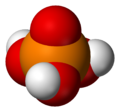**Production and Purification:**
– Phosphoric acid is produced through wet or dry processes.
– Wet process involves treating phosphate-containing minerals with sulfuric acid.
– Dry process involves reducing phosphate ore with coke in an electric arc furnace.
– Thermal process produces high-concentration phosphoric acid.
– Purification methods include liquid-liquid extraction and nanofiltration.
– Nanofiltration reduces impurities like cadmium and aluminum.
– Fractional crystallization produces high-purity phosphoric acid.
– Static crystallizers are used in the fractional crystallization process.
**Properties and Acidic Properties:**
– Phosphoric acid behaves as a triprotic acid in aqueous solution.
– Aqueous solutions exhibit freezing-point depression.
– Concentrated phosphoric acid may resist crystallization.
– Phosphoric acid can undergo self-condensation.
– pH adjustments yield monohydrogen phosphate or dihydrogen phosphate.
– Different pH values determine the type of phosphate salts formed.
**Industrial Uses:**
– Dominant use is in fertilizers, consuming approximately 90% of production.
– Used as a food and beverage acidifier and preservative.
– Contributes to the tangy taste in colas and jams.
– Soft drinks containing phosphoric acid can cause dental erosion.
– Potential to contribute to kidney stone formation, especially in excessive consumption.
**Safety Concerns:**
– Phosphoric acid can cause skin irritation at moderate concentrations.
– Concentrated solutions can lead to severe skin burns and permanent eye damage.
– Long-term regular cola intake linked to osteoporosis in women.
– Safety data sheets list phosphoric acid as immediately dangerous to life or health at certain concentrations.
– Colas associated with low bone mineral density in older women.
**Additional Information:**
– Safety information related to phosphoric acid can be found in the NIOSH Pocket Guide to Chemical Hazards.
– Various studies and articles provide data on the density, solubilities, and vapor pressure of phosphoric acid solutions.
– Books and publications cover topics such as purification, uses, and technology of phosphoric acid.
– Industry sources provide information on production, purification, and additives of phosphoric acid.
– Guidelines on dietary and pharmacologic management to prevent health issues related to phosphoric acid consumption are available.
Phosphoric acid (orthophosphoric acid, monophosphoric acid or phosphoric(V) acid) is a colorless, odorless phosphorus-containing solid, and inorganic compound with the chemical formula H3PO4. It is commonly encountered as an 85% aqueous solution, which is a colourless, odourless, and non-volatile syrupy liquid. It is a major industrial chemical, being a component of many fertilizers.

| |||
| |||
| Names | |||
|---|---|---|---|
| IUPAC name
Phosphoric acid
| |||
| Other names
Orthophosphoric acid
| |||
| Identifiers | |||
3D model (JSmol)
|
|||
| ChEBI | |||
| ChEMBL | |||
| ChemSpider | |||
| ECHA InfoCard | 100.028.758 | ||
| EC Number |
| ||
| E number | E338 (antioxidants, ...) | ||
| KEGG | |||
PubChem CID
|
|||
| RTECS number |
| ||
| UNII | |||
| UN number | 1805 | ||
CompTox Dashboard (EPA)
|
|||
| |||
| |||
| Properties | |||
| H3PO4 | |||
| Molar mass | 97.994 g·mol−1 | ||
| Appearance | Colorless solid | ||
| Odor | Odorless | ||
| Density | 1.6845 g/cm3 (25 °C, 85%), 1.834 g/cm3 (solid) | ||
| Melting point | 42.35 °C (108.23 °F; 315.50 K) anhydrous 29.32 °C (84.78 °F; 302.47 K) hemihydrate | ||
| Boiling point |
| ||
| |||
| Solubility | Soluble in ethanol | ||
| log P | −2.15 | ||
| Vapor pressure | 0.03 mmHg (20 °C) | ||
| Conjugate base | Dihydrogen phosphate | ||
| −43.8·10−6 cm3/mol | |||
Refractive index (nD)
|
| ||
| Viscosity | 2.4–9.4 cP (85% aq. soln.) 147 cP (100%) | ||
| Structure | |||
| Monoclinic | |||
| Tetrahedral | |||
| Thermochemistry | |||
Heat capacity (C)
|
145.0 J/(mol⋅K) | ||
Std molar
entropy (S⦵298) |
150.8 J/(mol⋅K) | ||
Std enthalpy of
formation (ΔfH⦵298) |
−1271.7 kJ/mol | ||
Gibbs free energy (ΔfG⦵)
|
−1123.6 kJ/mol | ||
| Hazards | |||
| GHS labelling: | |||
 | |||
| Danger | |||
| H290, H314 | |||
| P280, P305+P351+P338, P310 | |||
| NFPA 704 (fire diamond) | |||
| Flash point | Non-flammable | ||
| Lethal dose or concentration (LD, LC): | |||
LD50 (median dose)
|
1530 mg/kg (rat, oral) | ||
| NIOSH (US health exposure limits): | |||
PEL (Permissible)
|
TWA 1 mg/m3 | ||
REL (Recommended)
|
TWA 1 mg/m3 ST 3 mg/m3 | ||
IDLH (Immediate danger)
|
1000 mg/m3 | ||
| Safety data sheet (SDS) | ICSC 1008 | ||
| Related compounds | |||
Related phosphorus oxoacids
|
|||
Except where otherwise noted, data are given for materials in their standard state (at 25 °C [77 °F], 100 kPa).
| |||
The compound is an acid. Removal of all three H+ ions gives the phosphate ion PO3−4. Removal of one or two protons gives dihydrogen phosphate ion H2PO−4, and the hydrogen phosphate ion HPO2−4, respectively. Phosphoric acid forms esters, called organophosphates.
The name "orthophosphoric acid" can be used to distinguish this specific acid from other "phosphoric acids", such as pyrophosphoric acid. Nevertheless, the term "phosphoric acid" often means this specific compound; and that is the current IUPAC nomenclature.



